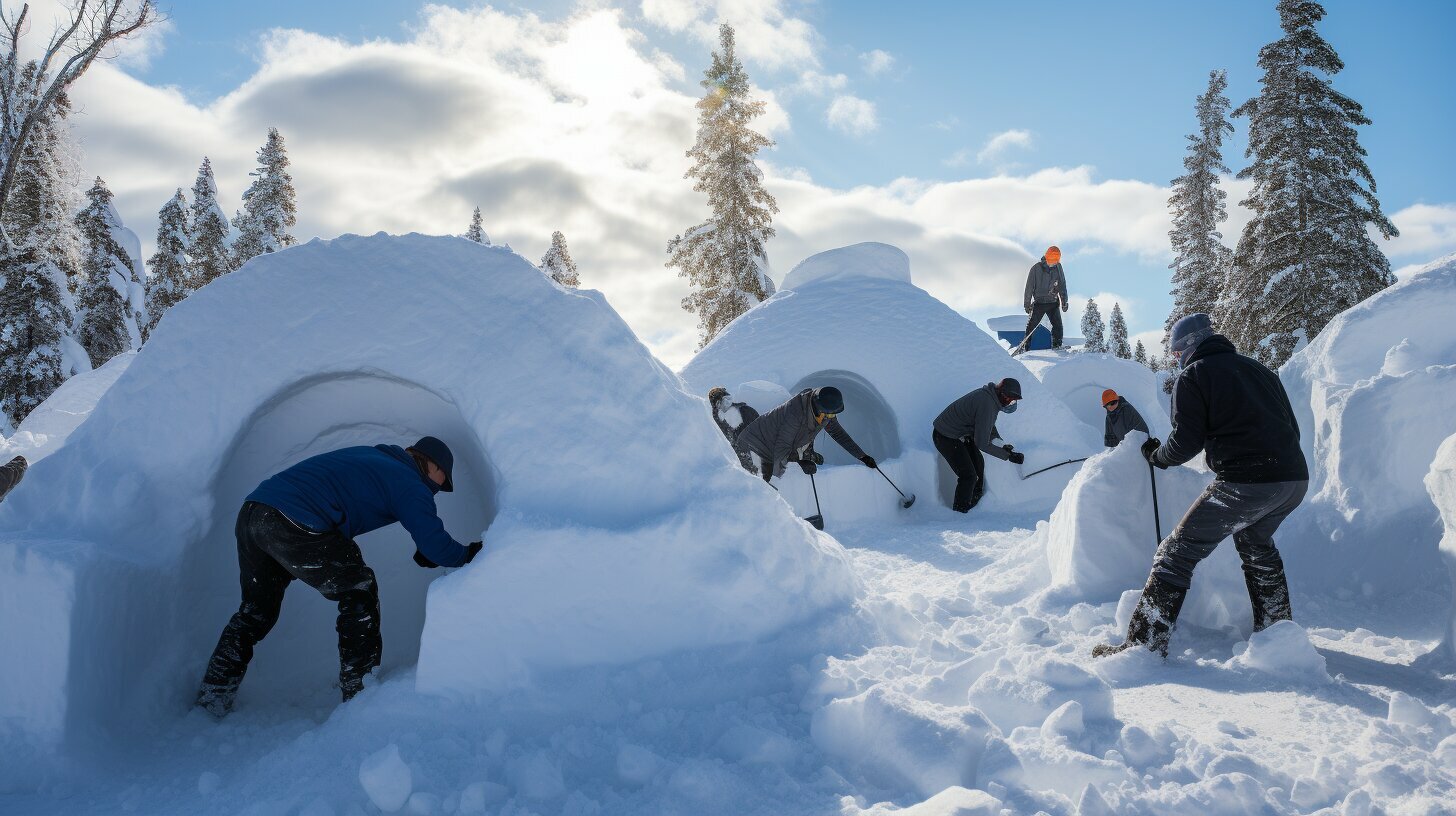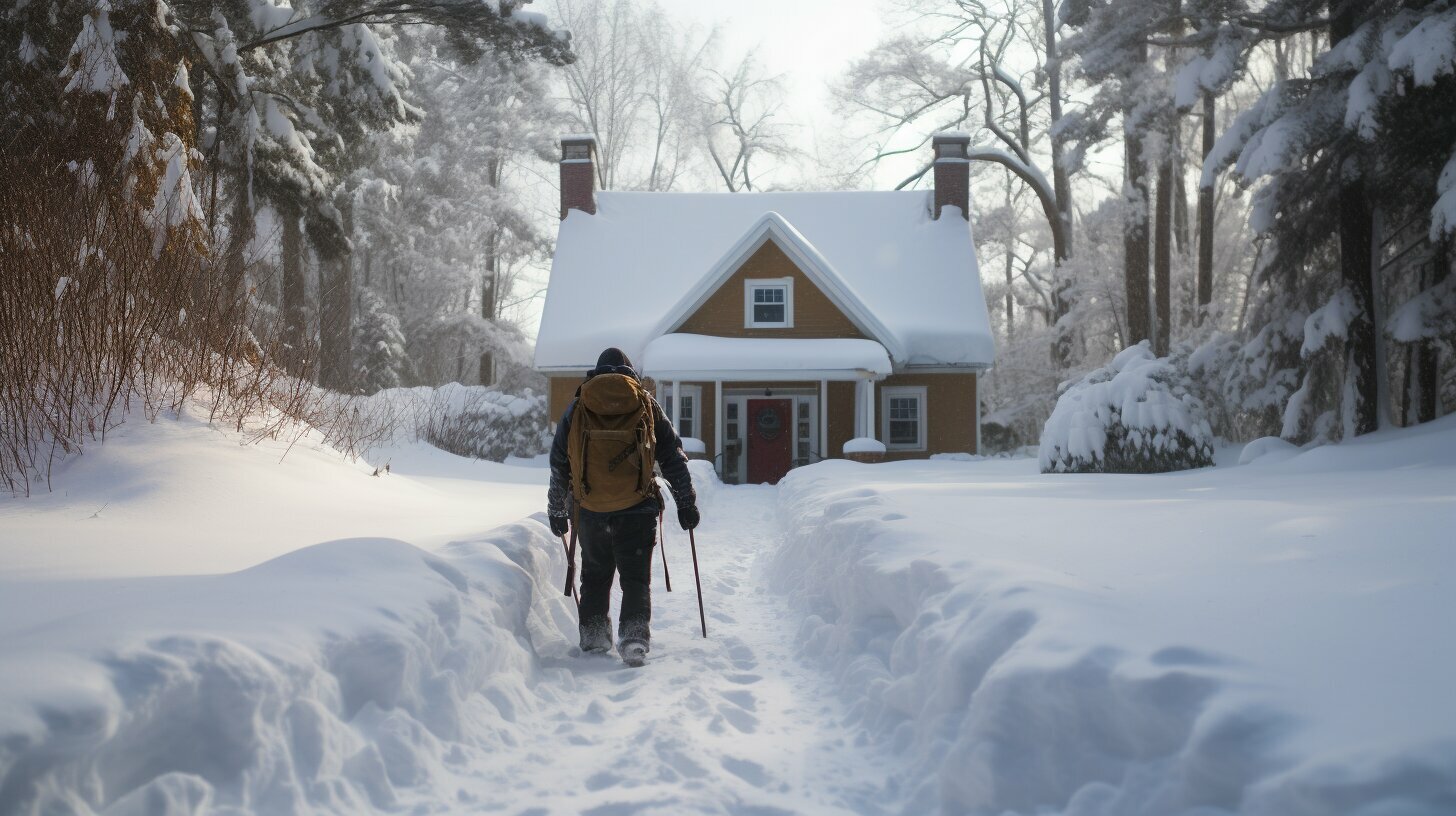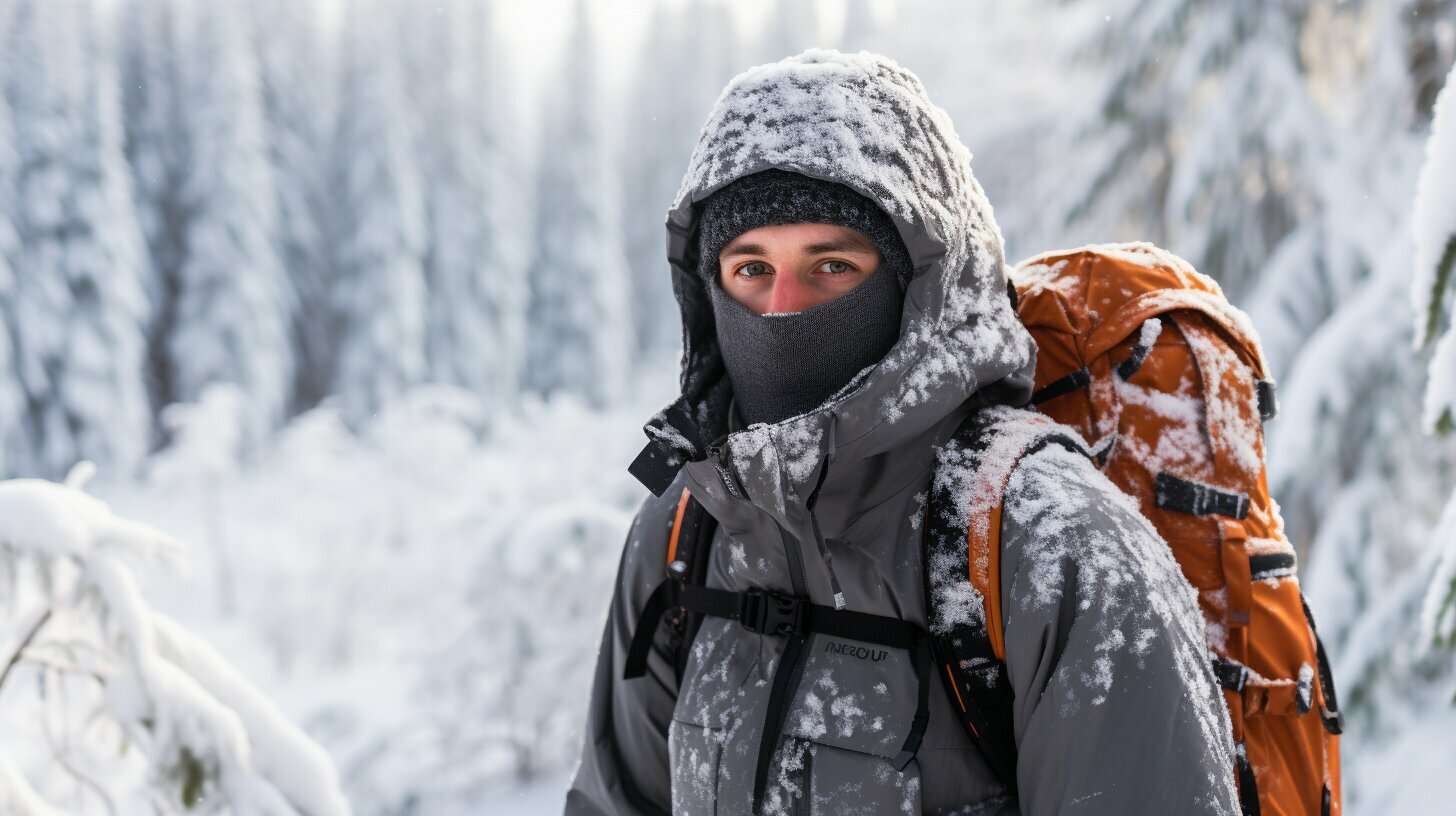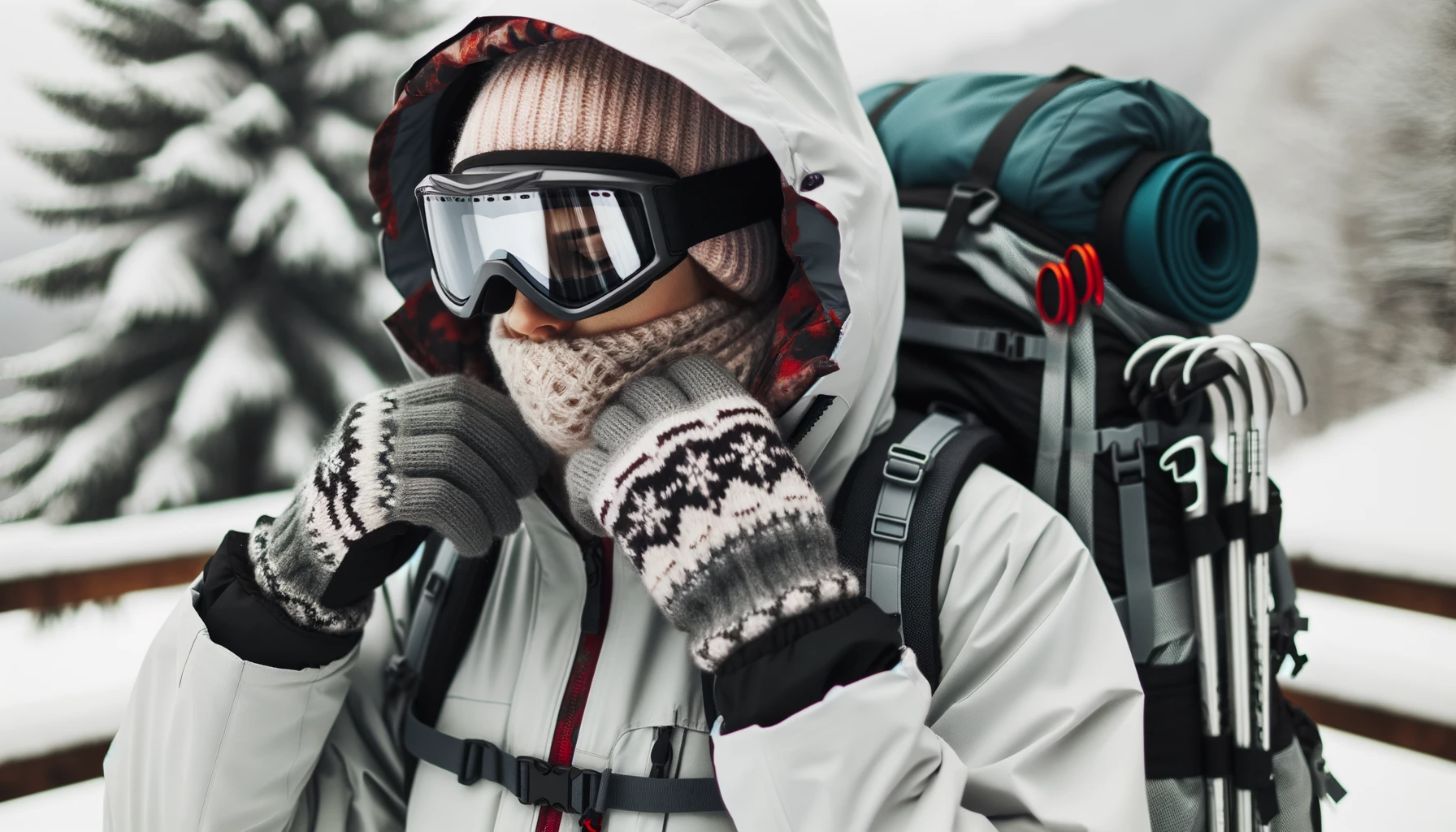Winter can be a beautiful time, but it can also be hazardous if you’re not adequately prepared. Having a sturdy shelter can make all the difference in surviving the colder months. That’s where quinzees come in – these DIY winter shelters made of snow can provide reliable protection from the elements. In this section, we’ll explore quinzees for winter shelters and how you can build them yourself.
Creating a quinzee may seem daunting, but with the right tools and techniques, anyone can do it. Not only is it a cost-effective option, but it can also be a fun winter activity. By building your own quinzee, you can ensure that it’s tailored to your specific needs and preferences.
Disclosure: When you buy through links on our site, we may earn an affiliate commission.
In the following sections, we’ll discuss what a quinzee is and why it’s an excellent choice for winter survival. We’ll also guide you through the steps to building a quinzee and offer tips for enhancing its durability, insulation, and overall comfort and safety. By the end of this article, you’ll have all the knowledge necessary to build your own quinzee and stay safe and warm during the winter season.
Key Takeaways
- Quinzees are DIY winter survival shelters made of snow.
- They provide reliable protection from the elements and can be a cost-effective option.
- Building a quinzee is a fun winter activity that can be tailored to your specific needs.
- In the following sections, we’ll discuss what a quinzee is, how to build one, and tips for enhancing its durability, insulation, and overall comfort and safety.
- By the end of this article, you’ll be equipped with all the knowledge necessary to build your own quinzee and stay safe and warm during the winter season.
Understanding Quinzees for Winter Shelters
If you are planning to build a winter survival shelter, it’s essential to consider the various options available. Among the popular choices are quinzees for winter shelters, which can provide adequate insulation and protection from the cold and winds.
A quinzee is a snow shelter that is made by piling up snow and then carving out the interior space. It is similar to an igloo, but instead of using blocks of ice, you use snow. Quinzees have been used for centuries by indigenous peoples in the Arctic regions and have proven to be an effective winter shelter option.
The key feature of a quinzee is its insulating properties. The thick layer of snow surrounding the interior space can trap body heat and keep you warm even in sub-zero temperatures. Quinzees are also relatively easy to construct and require minimal tools and equipment.
However, it’s important to note that quinzees for winter shelters are not suitable for all winter conditions. They are best used in areas with dry and powdery snow, as wet or compacted snow can compromise the stability and insulation of the shelter.
Overall, understanding quinzees and their features is the first step towards building a reliable winter survival shelter. In the next section, we will discuss how to select the right location for your quinzee to ensure its stability and safety.
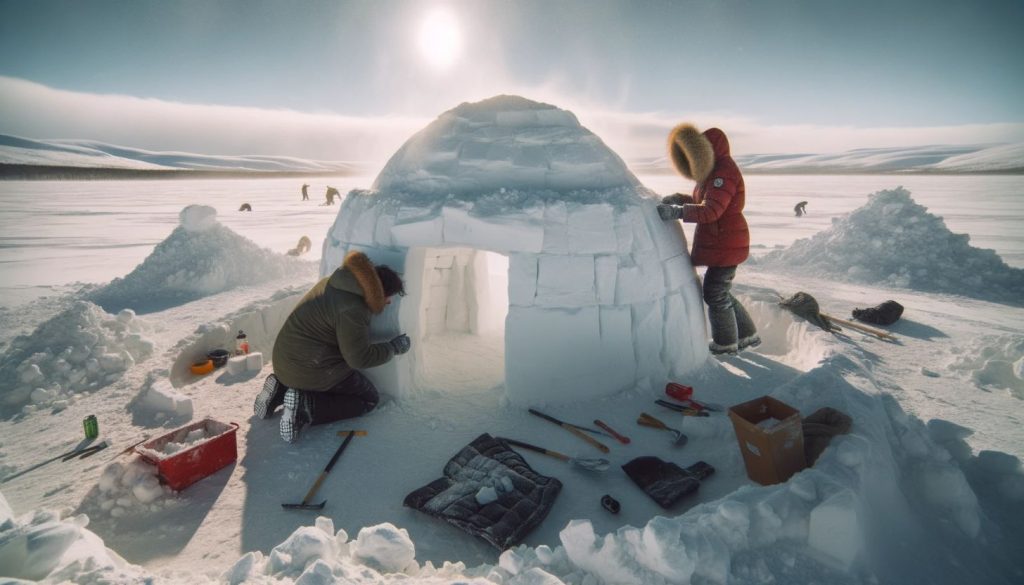
Selecting the Right Location for Your Quinzee
Choosing the location to build your quinzee is crucial for your shelter’s stability and efficiency in insulating against the cold weather. Before you create your snow shelter, ensure that you scout the area first and assess the terrain and snow conditions.
Finding the Ideal Spot for Your Quinzee
Identify a flat spot and an area that is free of any obstacles such as rocks or trees. Your chosen site should have enough snow, measuring at least eight feet deep, to provide good insulation and be able to create a sturdy shelter. Avoid areas that have been exposed to strong winds and direct sunlight, as these can lead to inconsistent snow depths and unstable snow banks that can threaten the safety of your shelter.
The location of your quinzee also determines the amount of shade it will receive. You want your shelter to be in a moderately shaded spot as direct sunlight can melt your snow shelter, making it damp and inefficient in retaining heat.
Orientation
The position in which you build your quinzee will have a significant impact on your shelter’s efficiency. The entrance should face downwind to prevent the accumulation of snow and to maintain a stable temperature and air pressure in your shelter. Avoid building your quinzee on slopes as these areas may be prone to avalanches or structural collapses.
Preparing the Site
Before putting up your quinzee, clear away any loose snow and pack the area where you intend to build your shelter. Use your snowshoes or skis to tramp down the area to create a firm foundation for your shelter. It is also essential to mark the location of the entrance and carve out a designated area where you will be digging out snow to create your shelter’s interior space.
Once you’ve identified the ideal spot to build your quinzee, you can start gathering the necessary tools and equipment for construction.
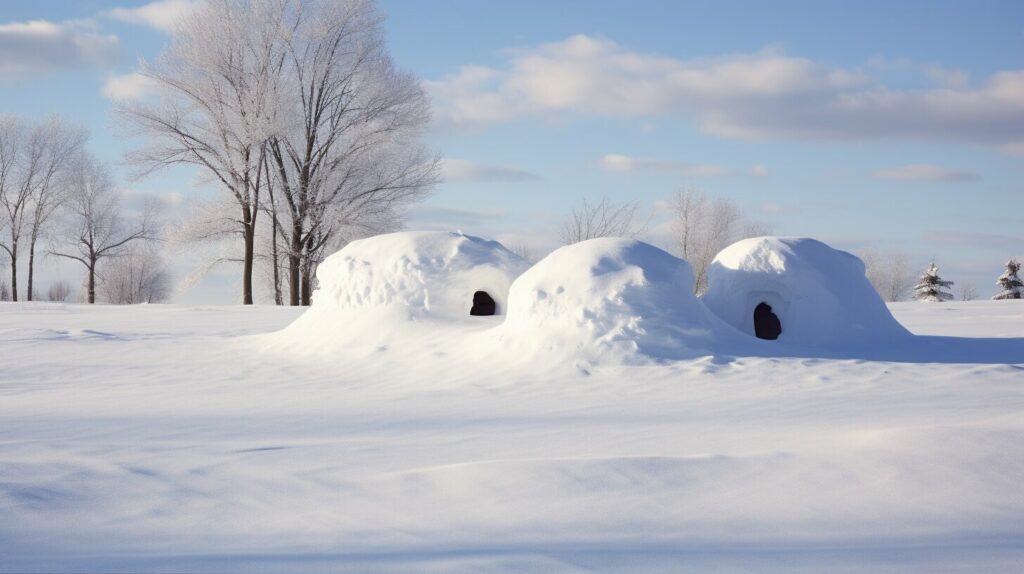
Gathering the Necessary Tools and Equipment
Building a quinzee for your DIY winter shelter requires specific tools and equipment. Here’s a list of items you’ll need:
| Tool/Equipment | Purpose |
|---|---|
| Shovel | To dig the snow mound |
| A saw or hatchet | To cut blocks of snow |
| A snow saw | To shape the snow blocks into the desired shape |
| A rope or cord | To measure the size of the snow mound and ensure consistent shaping |
| Buckets or containers | To transport snow and water for added stability and insulation |
If you don’t have access to specialized gear, don’t worry. There are alternative materials and techniques you can use to build your outdoor winter shelter. For instance, if you don’t have a snow saw, you can use a large knife or other cutting tools to shape the snow blocks. Additionally, you can use natural materials like sticks or pine needles to reinforce the shelter’s walls and improve insulation.
Remember to check your equipment before starting the construction process to ensure they are in working condition and sharp. Dull blades or worn-out shovel blades can make it difficult to cut and shape snow blocks precisely, leading to an unstable and less-insulated shelter.
Now that you have gathered the necessary tools and equipment, it’s time to move on to the construction process. Follow the step-by-step guide in section 5 to build your perfect quinzee for a winter camping experience.
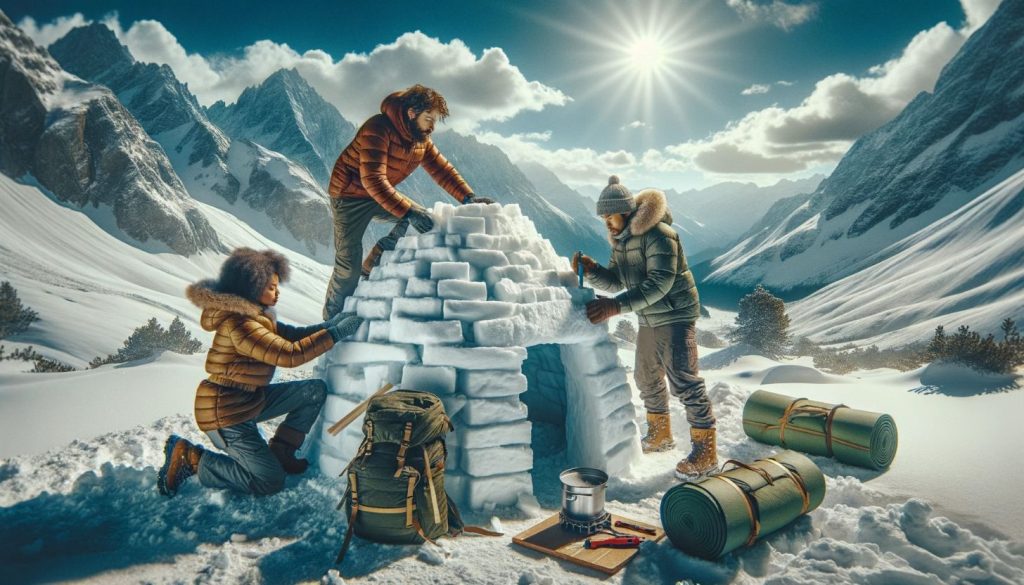
Step-by-Step Guide to Building a Quinzee
Building a quinzee can be a fun and rewarding project, but it’s important to follow the proper steps to ensure your shelter is sturdy and well-insulated. Here’s a step-by-step guide to building a quinzee:
Step 1: Find a Suitable Location
The first step in building a quinzee is finding a suitable location. Look for an area with plenty of snow and a relatively flat surface. It’s important to avoid areas with potential hazards such as avalanches or falling trees.
Step 2: Create a Snow Mound
The next step is to create a snow mound. This will serve as the foundation of your quinzee. Pile up snow into a mound about 7-8 feet in diameter and 4-5 feet tall.
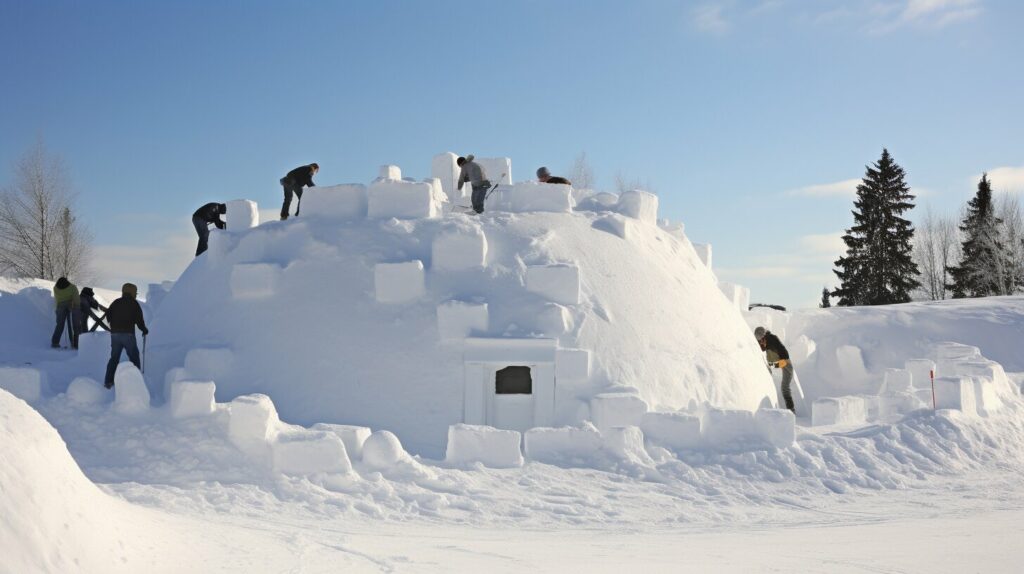
Step 3: Let the Snow Settle
Let the snow settle for at least an hour before continuing to the next step. This will allow the snow to compact and become more stable.
Step 4: Carve Out the Interior Space
Once the snow has settled, use a long stick or ski pole to mark the outline of your shelter. Then, use a snow shovel or snow saw to carve out the interior space. Leave the walls at least a foot thick for insulation.
Step 5: Create an Entrance
Next, create an entrance by carving a tunnel that slopes upward. This will help to trap warm air inside the shelter and prevent cold air from entering.
Step 6: Smooth Out the Interior Walls and Floor
Use your hands or a snow scraper to smooth out the interior walls and floor of the shelter. This will help to create a more comfortable and functional space.
Step 7: Create Ventilation Holes
Finally, create ventilation holes near the top of the shelter to allow fresh air to circulate. This will help to prevent condensation and ensure a comfortable living environment.
Congratulations! You’ve successfully built your very own quinzee. Remember to follow proper safety precautions and maintain your shelter regularly to ensure it lasts throughout the winter season.
Essential Tips for Quinzee Construction
Building a quinzee can be a challenging task, but with careful planning and attention to detail, you can construct a sturdy and insulated winter shelter. In this section, we will provide you with crucial tips for enhancing the durability, insulation, and overall safety of your quinzee.
Monitor Snow Conditions
One of the essential factors in constructing a quinzee is monitoring the surrounding snow conditions. The snow you use for building your quinzee must be dense and sturdy enough to avoid any structural collapse. Before building, ensure that the snow is at least four feet deep and of suitable consistency.
Choose the Right Tools
Having the right tools is crucial for building an efficient quinzee. Some of the necessary tools include shovels, saws, and snow knives. A snow saw is particularly useful for cutting blocks of snow quickly. If you don’t have access to specialized gear, you can also use plastic buckets, bowls, or baking pans to create blocks of snow.
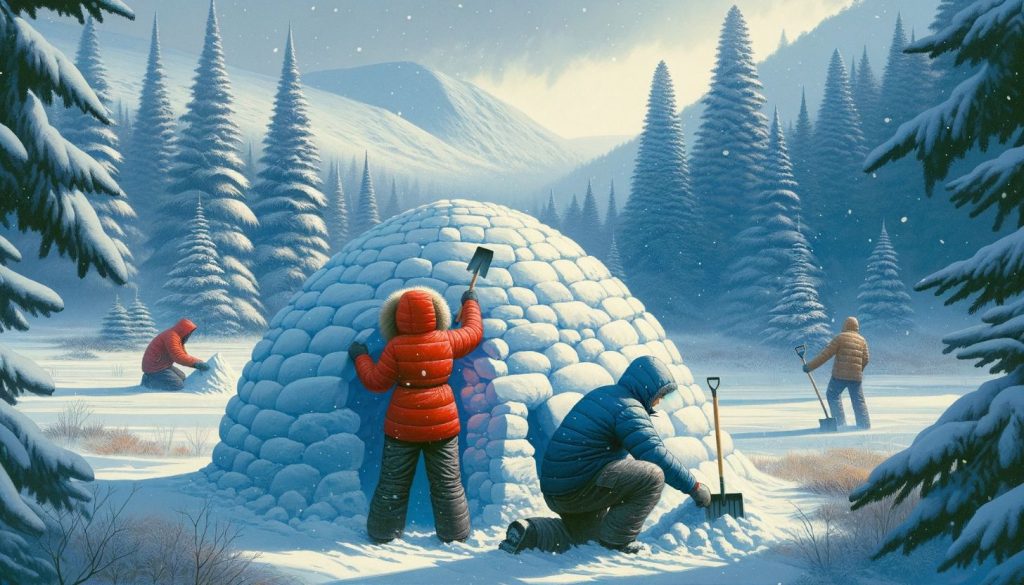
Build a Solid Foundation
Building a strong foundation is essential for the stability and durability of your quinzee. Begin by packing down the snow at the desired location to create a flat surface. Then, create a ring or border out of snow to mark the size and shape of your quinzee, packing the snow tightly to form a sturdy perimeter.
Shape the Quinzee Walls
After you’ve marked your quinzee’s perimeter, begin excavating the interior snow. Create a spiral-shaped trench inside the walls, slowly working your way from the perimeter towards the center. Remove the blocks of snow, placing them outside the perimeter of the quinzee. Continue to dig the trench until you’ve achieved the desired thickness for the walls. The ideal thickness for the walls is 1.5 to 2 feet.
Create an Air Vent
Good air circulation is essential inside your quinzee to prevent suffocation and maintain air quality. Creating an air vent helps regulate the temperature inside your quinzee and prevents the accumulation of carbon dioxide. Ensure that the hole for the air vent is slightly higher on the wall opposite the entrance to allow for natural ventilation.
Add Insulation
Insulating your quinzee is a crucial step in maintaining warmth inside your shelter and preventing the cold from penetrating. You can insulate the walls of your quinzee using pine boughs, sleeping mats, or blankets. Cover the entire floor of the quinzee with boughs, and then add your sleeping bag or mat on top.
Consider Emergency Situations
It’s essential to consider emergency situations when building your quinzee. Always pack an emergency kit with a first aid kit, extra warm clothes, and food and water. If you plan to stay the night, carry a portable stove to melt snow for drinking water. Ensure the entrance of your quinzee is appropriately marked with a pole or flag to avoid getting lost in a snowstorm.
By following these essential tips, you can build a sturdy and well-insulated quinzee for your winter shelter. Remember to monitor the snow conditions, choose the right tools, build a solid foundation, shape the walls correctly, add insulation, and consider emergency situations. Stay safe and warm inside your quinzee throughout the winter season.
Maintaining and Repairing Your Quinzee
Your quinzee is your safe haven in the winter wilderness, providing you with warmth and shelter from the cold and snow. It’s essential to keep your quinzee well-maintained to ensure its structural integrity and insulation efficiency throughout the winter season.
Regular Maintenance
Regularly inspect your quinzee for any signs of damage or wear and tear. Check the walls and ceiling for cracks or holes that may compromise the insulation. Remove any loose or accumulated snow from the exterior of your quinzee to prevent excessive weight and snow melting.
Ventilate your quinzee by creating a small opening or tunnel at the top of the ceiling to allow for air circulation and prevent condensation buildup.
To enhance the insulation, add a layer of snow or spruce boughs on the floor and walls of your quinzee. This will help trap heat inside and prevent it from escaping through the cold ground.
Repairing Your Quinzee
If you notice any damages or holes, repair them immediately to avoid further deterioration of your quinzee. Use snow to fill in any gaps or holes in the walls or ceiling, and pack it firmly to ensure insulation efficiency.
If your quinzee collapses or sustains significant damage, you may need to rebuild it entirely. In this case, follow the same steps outlined in Section 5 to construct a new quinzee.
Your DIY Winter Shelter Equipment
Be sure to have a shovel and snow saw with you to maintain and repair your quinzee. It’s also a good idea to have a spare tarp or canvas to cover the entrance of your quinzee in case of a storm or high winds.
With proper maintenance and repairs, your quinzee can provide you with a reliable and comfortable winter shelter throughout the season.
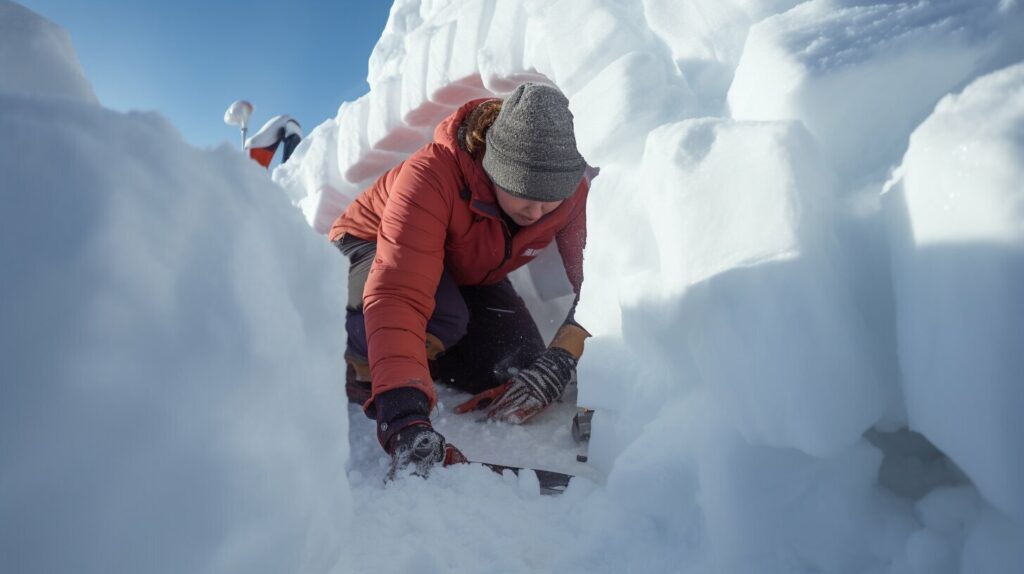
Enhancing Comfort and Safety in Your Quinzee
While a quinzee provides excellent protection from the cold, it’s important to take additional measures to enhance your comfort and safety during winter camping. You can achieve this by focusing on insulation techniques, ventilation options, and essential safety precautions.
Insulation Techniques
An ideal winter camping shelter should keep you warm and cozy throughout the night. To achieve this, consider the following insulation techniques:
- Fill any air pockets in the snow with loose snow or clothing to prevent cold air from entering the quinzee.
- Add a layer of insulating material, like pine boughs or sleeping pads, to the floor of the shelter to insulate from the cold ground.
- Hang blankets or sleeping bags on the interior walls of the quinzee to help retain heat.
The insulation measures you take will depend on the conditions and climate you’re camping in, but these tips can serve as a baseline for enhancing your insulation.
Ventilation Options
While insulation is essential for staying warm, it’s important to ensure that the shelter is well-ventilated to prevent moisture buildup and air stagnation. Here are some ventilation options:
- Open a small ventilation hole near the top of the quinzee to let out stale air and moisture.
- Leave a small gap in the entrance of the shelter to allow for air circulation.
- Monitor the interior moisture levels of the shelter with a handheld hygrometer and make necessary ventilation adjustments.
Proper ventilation is essential for maintaining good air quality and preventing respiratory issues during winter camping.
Essential Safety Precautions
Winter camping can present many hazards, and it’s important to take necessary safety measures to ensure a secure experience. Here are some essential safety precautions:
- Always have a source of light, such as a headlamp or flashlight, available in the shelter.
- Keep a first aid kit and emergency supplies, such as food and water, readily available.
- Double-check that all gear is functioning properly before heading out into the cold.
- Inform someone of your camping plans, including location and expected return date and time.
By following these safety precautions, you can reduce the risk of injury or emergency situations during your winter camping trip.
By enhancing your insulation, ventilation, and safety measures, you can enjoy a comfortable and secure experience in your quinzee winter camping shelter. Happy camping!
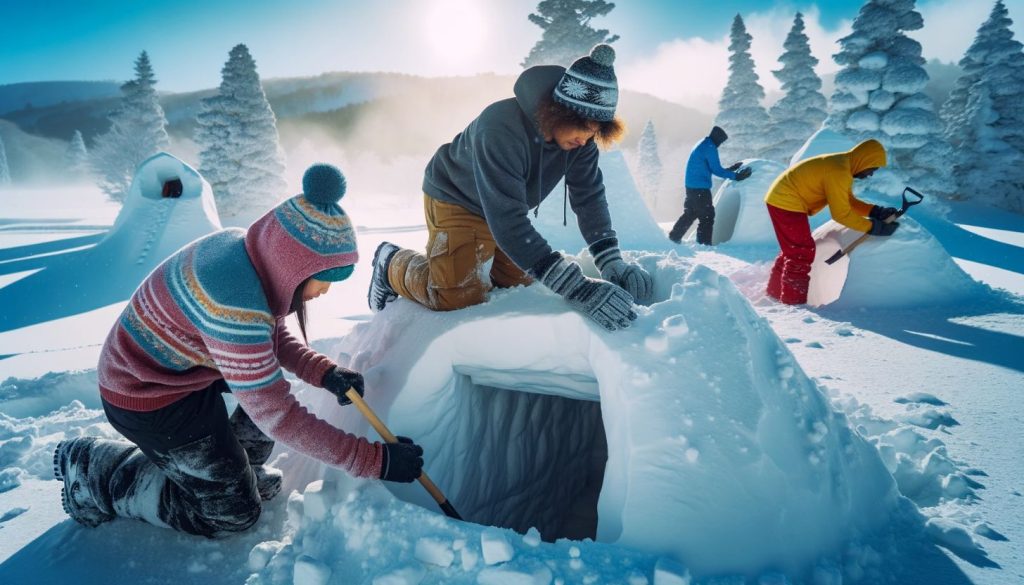
Alternative Winter Shelter Options
While quinzees are a popular choice for DIY outdoor winter shelters, it’s essential to know your other options. Depending on the situation and available resources, other shelter options may be more suitable for your needs.
Snow Caves
Snow caves are shelters dug into the side of a snowdrift or bank. They can be an excellent option if you’re in an area with deep snow. The snow acts as insulation, making the inside of the cave warmer than outside temperatures. To create a snow cave, dig a hole into the snow, and then use snow blocks to build a dome shape over the entrance. The entrance should slope downward to prevent heat loss and trap warm air inside.
Snow Forts
Snow forts are a fun and alternative winter shelter option, especially for groups of people. They are also ideal for families with young children. Snow forts are built by stacking and packing snow into thick walls. The structure can be made round, square, or any other shape. After the walls are built, a roof is added, and the interior can be decorated with blankets and other insulating materials.
Emergency Shelters
In case of an emergency, such as being stranded while hiking or camping, it’s essential to have a resourceful shelter. Emergency shelters are designed to be quickly assembled and provide temporary protection from the elements. They come in different sizes and shapes and can be made from materials such as space blankets, tarps, and bivy sacks. Having an emergency shelter in your outdoor survival kit can be a lifesaver, ensuring you can stay warm and dry until help arrives.
Now that you know your options for DIY winter shelters, you can choose the best option for your situation. Whether you decide to build a quinzee, snow cave, snow fort, or have an emergency shelter at the ready, it’s essential to be prepared for the winter outdoors. Always have the necessary tools and equipment, keep safety in mind, and enjoy your outdoor winter experience to the fullest.
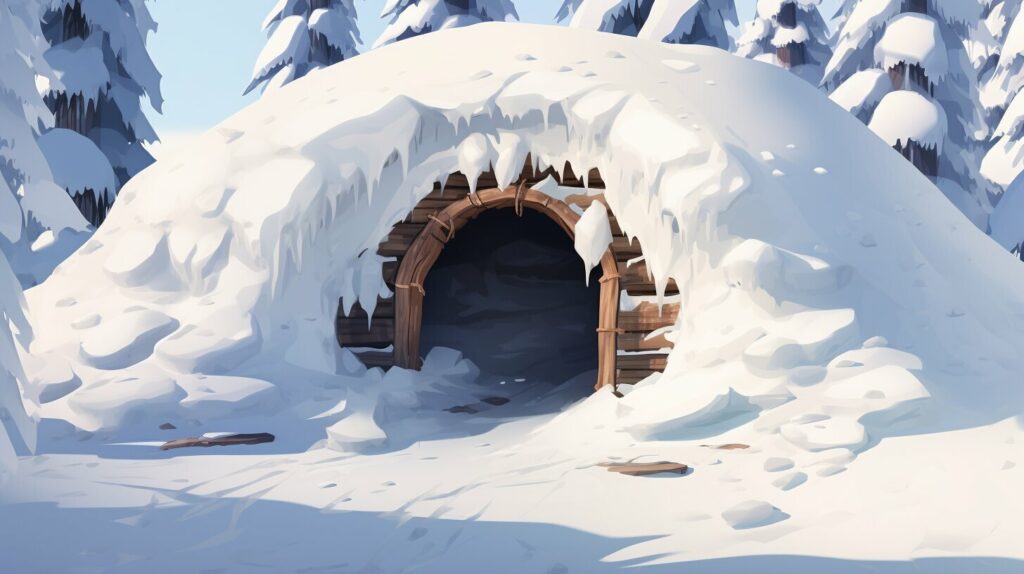
Conclusion
By mastering the art of building quinzees for winter shelters, you have equipped yourself with essential survival skills in freezing conditions.
As you have learned, quinzees are an effective option for winter survival shelters. By following the step-by-step guide and implementing the tips provided, you can stay protected and prepared during winter camping or emergency situations.
Remember to choose an appropriate location, gather the necessary tools, and follow the construction steps carefully. Maintaining and repairing your quinzee regularly is also essential to ensure its durability throughout the winter season.
Additionally, consider enhancing comfort and safety inside your quinzee through insulation techniques, ventilation options, and essential safety precautions.
If quinzees don’t suit your needs, remember that there are alternative winter shelter options such as snow caves, snow forts, and emergency shelters. These options could be worth exploring further.
Stay safe and enjoy the winter wonderland with your well-built quinzee!
FAQ
What is a quinzee?
A quinzee is a type of winter shelter that is constructed using snow. It is essentially a mound of snow that is hollowed out to create a cozy interior space.
Why should I choose a quinzee for my winter shelter?
Quinzees are a great choice for winter shelters because they provide excellent insulation and protection from the cold. The thick walls of snow help to trap heat inside, keeping you warm even in freezing temperatures.
How do I choose the right location for my quinzee?
When selecting a location for your quinzee, consider factors such as snow conditions, terrain, and shelter positioning. Look for an area with compacted snow that is away from potential hazards like tree branches or slopes.
What tools and equipment do I need to build a quinzee?
To build a quinzee, you will need tools like a snow shovel, a snow saw, and a sturdy tarp. If you don’t have access to specialized gear, you can also use alternatives like wooden sticks or your hands for shaping the snow mound.
Can I use materials other than snow to build a quinzee?
While snow is the traditional material used for building quinzees, you can also use other insulating materials like leaves or branches in the construction process. These alternative materials can help enhance the insulation properties of your shelter.
How do I build a quinzee step by step?
Building a quinzee involves creating a snow mound and then hollowing it out to create a sheltered interior space. Step-by-step instructions can be found in Section 5 of this guide.
Are there any tips to enhance the durability and safety of my quinzee?
Yes, in Section 6, you will find valuable tips and techniques to enhance the durability, insulation, and overall safety of your winter shelter. These tips include reinforcing the walls, creating proper ventilation, and making necessary adjustments in emergencies.
How do I maintain and repair my quinzee?
Quinzees require regular maintenance to ensure their stability and effectiveness. Section 7 provides guidance on how to maintain your quinzee throughout the winter season and offers troubleshooting tips for common issues that may arise.
What can I do to enhance comfort and safety inside my quinzee?
In Section 8, you will find techniques to enhance comfort and safety in your quinzee. This includes insulation techniques, ventilation options, and essential safety precautions to make your winter camping experience more comfortable and secure.
Are there any alternative winter shelter options?
Yes, Section 9 briefly explores alternative winter shelter options such as snow caves, snow forts, and emergency shelters. These options may be suitable for different situations, and their construction and features are discussed.

